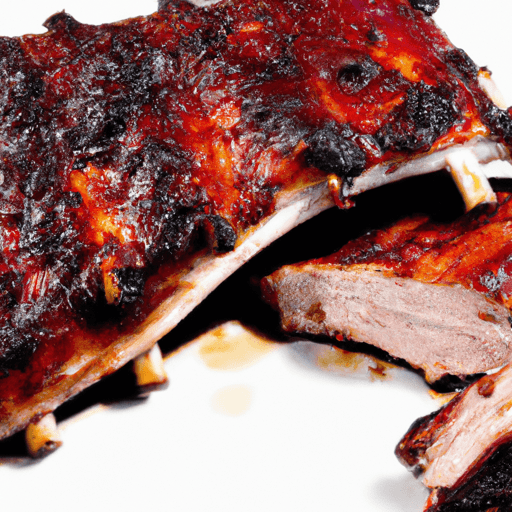The All-American Ribs: A Tantalizing Journey for Your Taste Buds
When it comes to quintessential American barbecue, one dish stands head and shoulders above the rest – ribs. Whether you’re firing up the grill for a backyard cookout or stepping into a smoky BBQ joint, the irresistible aroma and succulent flavors of American ribs will leave you craving for more. Let’s dive into the wonderful world of American ribs and uncover their secrets!
A Tender and Flavorful Delight
American ribs are a cut of meat that comes from the rib section of either pork or beef. Known for their tender texture and rich flavor, they are a staple in barbecues and grilling across the United States. The meat is typically slow-cooked to perfection, allowing the flavors to develop and the meat to become fork-tender. The key to achieving this mouthwatering tenderness lies in low and slow cooking, giving the connective tissues enough time to break down and infuse the meat with a smoky goodness.
Versatile in the Kitchen
American ribs lend themselves to a multitude of culinary creations. Whether you prefer sticky and sweet, boldly spiced, or tangy and smoky, there’s a rib recipe to suit every palate. The most common cooking methods include grilling, smoking, and oven-baking, each yielding slightly different flavors and textures.
While barbecue sauce is often associated with ribs, dry rubs are also incredibly popular. Ranging from simple salt and pepper to complex spice blends, dry rubs add layers of flavor to the meat before cooking. This versatile approach allows for countless variations and regional adaptations, making American ribs a true expression of culinary creativity.
Apart from being the star of barbecue parties, ribs can also shine in other dishes. They add a delightful touch when incorporated into stews, chili, or even tacos. The tender meat easily falls off the bone, making it a fantastic addition to any recipe that calls for a hefty dose of flavor and substance.
A Nutritional Powerhouse
While indulging in American ribs is undoubtedly a treat for your taste buds, it’s essential to consider their nutritional value. Ribs can vary in fat content, depending on the cut and cooking method. Pork ribs tend to have more fat marbling, which contributes to their succulence. However, it’s important to remember that moderation is key when enjoying this rich and flavorful meat.
On the brighter side, ribs are packed with essential vitamins and minerals. They contain high levels of protein, necessary for muscle repair and growth. Moreover, they offer valuable nutrients like zinc, iron, and B vitamins, supporting vital bodily functions such as immune health and energy production.
A Celebrated Part of American Cuisine
American ribs have a fascinating history deeply intertwined with American tradition and culture. Dating back centuries, Native American tribes smoked and roasted ribs, developing techniques that laid the foundation for what we now consider classic American barbecue.
In the Southern United States, ribs became an integral part of the culinary landscape during the 19th century. African-American pitmasters brought their unique cooking techniques and flavors, adding layers of complexity to this beloved dish. Over time, barbecue competitions and regional preferences further shaped the landscape of American ribs, with diverse styles emerging across the country, from the sweet and sticky Kansas City-style to the tangy and vinegar-based Carolina-style.
Get Your Grill On!
Now that you’re armed with the knowledge of American ribs, it’s time to fire up the grill and embark on a flavorful journey. Whether you choose to slow-cook them until they’re fall-off-the-bone tender, slather them in a luscious barbecue sauce, or apply a tantalizing dry rub, American ribs are sure to satisfy even the most discerning carnivore.
So, gather your friends and family, bask in the smoky aroma, and savor every juicy bite. These all-American ribs are a true testament to the art of barbecue and a dish that will leave you coming back for seconds, and perhaps even thirds!
American Ribs
Origin: American ribs are a popular dish in the United States and have roots in various regional cuisines such as Southern, Texan, and Kansas City styles of barbecue. Texas-style ribs are often cooked over indirect heat using a dry rub, while Kansas City-style ribs are typically coated with a tomato-based sauce.
Common Uses: American ribs are commonly prepared by slow-cooking them over a grill, in a smoker, or in an oven. They can be enjoyed as a main dish or as part of a barbecue spread. These ribs are often served with barbecue sauce and can be accompanied by traditional sides such as coleslaw, cornbread, or baked beans.
Nutritional Benefits: American ribs can be a good source of protein, iron, zinc, and B vitamins. However, the nutritional content can vary depending on cooking methods and the use of sauces or rubs. It is important to note that ribs also tend to be high in saturated fat and calories, so moderation is key when incorporating them into a balanced diet.
Unique Properties/Historical Significance: American ribs, particularly those cooked using traditional barbecue methods, are known for their smoky flavor and tenderness. The process of slow-cooking ribs over low heat allows the fat and collagen to break down, resulting in a juicy and tender meat texture.
Ribs hold cultural significance in the United States, often being associated with gatherings, celebrations, and sporting events like tailgating or barbecues. The specific styles of American ribs, such as St. Louis-style or Memphis-style, have their own distinct techniques and flavor profiles, showcasing the diversity of American barbecue culture.




Use the share button below if you liked it.
It makes me smile, when I see it.